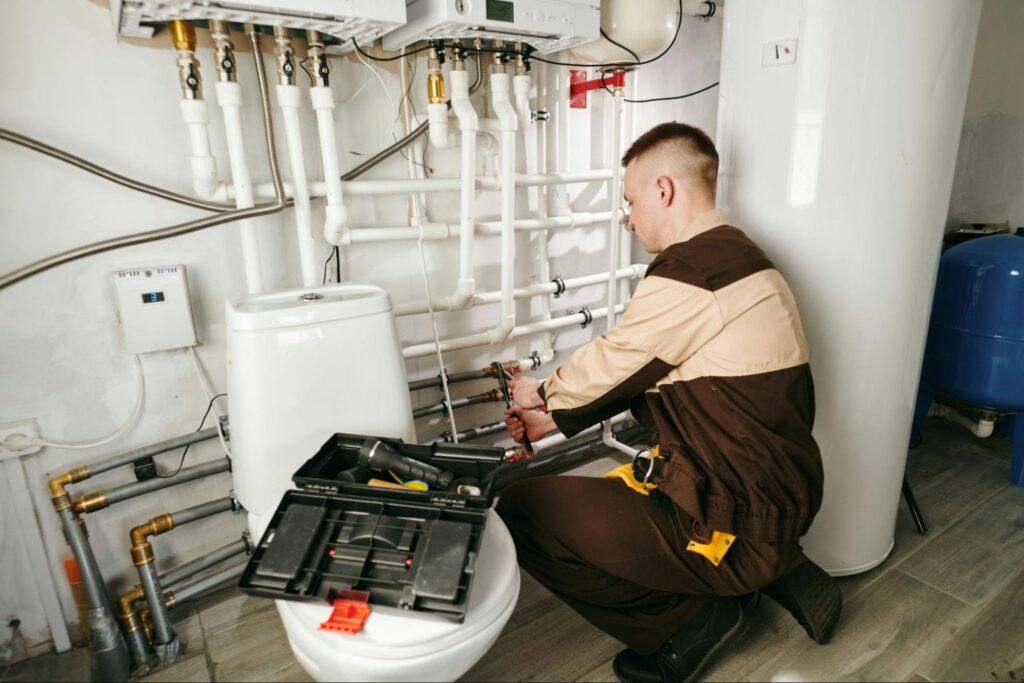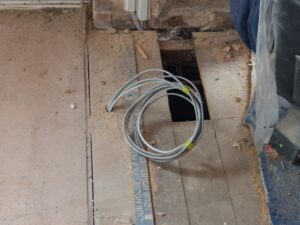Imagine this: you’re at home, working on a weekend project, and suddenly you realize that you’ve used up all your water. You turn on the faucet, but the hot water’s gone, or worse, you’re struggling with a septic backup.
Not exactly the ideal situation, right?
That’s where understanding how to plumb a septic tank comes in. Knowing how to set up and maintain your septic system prevents costly repairs and can save you from some pretty inconvenient situations.
The plumbing of a septic tank doesn’t have to be complicated, but it does require the right knowledge. Every detail matters, from connecting pipes properly to understanding the importance of venting and ensuring your drain field is functioning efficiently.
With the right guidance, you can manage your septic system confidently and avoid those all-too-common headaches that come with improper setup.
Here’s the thing: Septic systems are often overlooked until they malfunction, but with some know-how, you can ensure everything works smoothly from day one. Excel Mechanical is here to help make the process easier.
Whether you’re installing a new system or maintaining an existing one, our expert team will guide you every step of the way.
In this blog, we will cover:
- Understanding the key components of your septic system: What each part does and why it’s important.
- Preparation tips for a smooth installation: How to choose the right site, get the right permits, and ensure everything fits perfectly.
- Common troubleshooting tips: What to do when your septic system isn’t working properly, and how to maintain it to avoid issues.
Let’s get started!
Understanding Septic Systems
Septic systems are critical in managing wastewater in areas without centralized sewage systems. They comprise various components that work together to treat and dispose of waste efficiently.
Components of a Septic System
A septic system typically includes a septic tank, a distribution box, and a drain field.
- The septic tank is a buried, watertight container usually made of concrete, fiberglass, or polyethylene. It holds wastewater, allowing solids to settle and form sludge. Oils and grease rise to the top as scum.
- The distribution box helps evenly distribute wastewater from the tank to the drain field. Proper function prevents overloading parts of the system.
- The drain field, or leach field, is where wastewater is further treated by soil absorption. Pipes with holes allow water to seep into the ground, where natural processes purify it.
How Septic Systems Work
Wastewater from your home flows into the septic tank, where solids settle and begin to decompose.
Heavier materials sink, forming sludge, while lighter waste rises to form scum. This natural separation allows partially treated water to flow to the next component.
The distribution box channels this liquid to the drain field. The soil is a filter, where microbes break down harmful organisms. This process helps clean the water before it returns to the groundwater supply.
Preparation for Installation
Before installing a septic tank, evaluating the site, ensuring compliance with permits and regulations, choosing the right tank, and gathering the necessary tools and supplies is crucial.
These steps ensure a smooth installation process and long-term functionality.
Site Evaluation
It is essential to choose the best spot for your septic tank.
Begin by examining the soil type and drainage capacity. Soil with good drainage, like sandy soil, is preferable. Next, confirm that the area is large enough to hold the system while remaining safe from water sources and buildings.
Checklist:
- Assess the soil for drainage
- Measure available space
- Verify the distance from water wells
Finally, consider the topography.
A flat or gently sloping area is ideal for efficient tank placement. This evaluation is key to ensuring effective operation and preventing future issues.
Permits and Regulations
Check local regulations before proceeding.
Most areas require permits for septic tank installation. Visit your local health department or environmental agency to find specific rules. Following these regulations is essential to avoid fines and installation problems.
Steps to Take:
- Research local regulations
- Obtain necessary permits
- Schedule inspections
Keep a record of all permits and approvals.
This documentation confirms that you have followed all necessary regulations, ensuring smooth operation and legal compliance for your septic system.
Choosing the Right Tank
Choose a tank based on your household size and wastewater needs.
A larger household typically needs a bigger tank to handle the volume. Septic tanks come in various materials, such as concrete, polyethylene, or fiberglass.
Each material has different benefits and drawbacks.
Tank Considerations:
- Concrete: Durable and long-lasting
- Polyethylene: Lightweight and easy to install
- Fiberglass: Resistant to corrosion and cracking
Select the best option that meets your individual needs and budget.
Gathering Necessary Tools and Supplies
To install a septic tank, you need specific tools and materials.
Essential tools include a backhoe for digging, a level, pipes, and connectors. Materials like gravel and sand are needed for proper drainage around the tank.
Materials List:
- Backhoe
- Level
- Pipes and connectors
- Gravel and sand
Ensure accessibility to all required items before the project starts.
Installation Process
Installing a septic tank involves several critical steps: excavation, proper tank placement, secure connection of inlet and outlet pipes, and effective drain field installation. Precision and expertise in each step ensure a reliable and efficient system.
Excavation
Begin by determining the exact location for your septic tank.
Check local building codes to ensure compliance. A professional can help with surveying the land and marking the area accurately.
Excavate a hole that matches the dimensions of your septic tank. The hole should be large enough to accommodate the tank, ensuring extra space for backfilling. Digging to the correct depth is essential, so the tank sits level and at the appropriate height relative to your home’s plumbing.
Use a backhoe or other heavy equipment if available. Be cautious of existing underground utilities, and call a professional to avoid damage.
Proper excavation is crucial for preventing future problems like tank shifting or leakage.
Setting the Tank
Once your hole is ready, lower the septic tank into place.
This process typically requires a crane or hoist due to the tank’s weight and size. Ensure the tank is level and sits on a firm base of gravel or sand to prevent settling or shifting over time.
Align the tank openings with the predetermined inlet and outlet locations. After placing the tank, double-check its levelness, as an uneven tank can disrupt the flow and cause issues.
Adjust as needed to achieve a stable and correct setup.
Connecting Inlet and Outlet Pipes
It’s time to connect the inlet and outlet pipes to the tank.
The inlet pipe carries wastewater from your house, while the outlet pipe connects to the drain field. Use durable, high-quality pipes to ensure longevity and prevent leaks.
Ensure the inlet pipe has the correct slope to allow gravity to do its work. A common guideline is a slope of about 1/4 inch per foot of pipe. For the outlet pipe, maintain a similar slope toward the drain field.
Proper connection sealing is crucial. Use reliable sealing compounds or gaskets designed for septic systems to ensure watertight connections and prevent odor or leakage.
Installing the Drain Field
The drain field is vital for wastewater treatment.
- Plan the layout according to your local regulations and the available space.
- The field typically consists of a network of perforated pipes laid in gravel-filled trenches.
- Excavate the trenches for the drain field, ensuring they slope slightly away from the tank for efficient drainage.
- Place the pipes in the trenches and cover them with gravel to facilitate filtration and treatment of effluent.
- Finally, cover the gravel with soil or geotextile fabric to prevent contamination while allowing water to flow.
Testing and Initial Use
After installing a septic tank, it’s crucial to check for leaks, backfill properly, and follow the right start-up procedures. These steps ensure your tank operates smoothly and effectively from day one.
Leak Testing
It’s essential to test for leaks to prevent water contamination.
Start by filling the tank with water up to its regular operating level. This helps identify any loose connections or cracks that might leak.
Examine the area around the tank for damp spots or flowing water, which can indicate a leak. Pay close attention to connectors and joints; they’re common trouble spots. If you notice any issues, stop and fix them immediately to prevent bigger problems later.
Backfilling
Once leak testing is successful, the next step is backfilling the tank.
Choose the right materials, typically a mix of soil and sand, to avoid damage to the tank structure.
Begin adding backfill in layers, making sure each layer is level and compacted before adding more. Careful compaction prevents shifting and adds stability. Ensure there is no debris, large rocks, or sharp objects in the backfill that could scratch or damage the tank.
Take care when working around tanks with pipes and other connections to prevent accidental damage. This helps maintain the integrity of the entire septic system.
Initial Start-up Procedures
The initial start-up involves slowly adding wastewater to the tank.
Gradually increasing the amount helps acclimate the bacteria, which is crucial for breaking down waste. Monitor the system closely during this phase for any unusual signs, like odors or backups.
Avoid using excess water fixtures like showers or washing machines until the system is fully operational. This approach gives bacteria time to establish and begin processing waste effectively.
If you encounter any issues during this phase, consulting professionals like Excel Mechanical ensures smooth initial use. Our focus on tailored solutions helps avoid long-term issues, saving you time and money.
Maintenance Considerations
Maintaining your septic tank is crucial for ensuring its longevity and efficiency. Key maintenance tasks include regular inspections, scheduled pumping and cleaning, and promptly addressing common issues.
Regular Inspections
You should inspect your septic tank regularly to prevent large issues.
Check every three years and have a professional assess it. This can help spot potential problems early, like leaks or blockages.
Visual checks outside are also helpful. Observe wet spots or odors around the septic area. These signs might indicate a problem within the system.
Pumping and Cleaning
Regular pumping and cleaning are necessary for a well-functioning septic tank.
Depending on household use and tank size, you typically need to pump every three to five years.
During pumping, waste is removed, preventing solids from clogging the system. This process helps maintain the tank’s efficiency and prevents overflow issues. Cleaning also plays a key role in keeping pipes free of debris buildup.
Use a reputable service provider for this task. We focus on meeting individual needs and budgets.
Common Issues and Solutions
Septic systems can experience common problems, such as clogging, tree root intrusions, or leaks. These can cause backups or unpleasant odors. Address these issues quickly to avoid system damage.
- For clogs, avoid dumping non-biodegradable items down drains. Tree roots can infiltrate pipes, so maintain trees at a distance and inspect lines for intrusions.
- Leaks might occur from cracked tanks or damaged pipes. Repair these promptly to prevent further issues. Professional services from experienced plumbers can provide quick and effective solutions, ensuring your system runs smoothly.
- Lastly, it is crucial to educate yourself on what can harm your septic system.
Simple preventive measures go a long way toward maintaining their health.
Health and Safety Measures
When plumbing a septic tank, proper health and safety measures are vital. You’ll need to focus on wearing adequate gear and handling materials carefully to prevent accidents and ensure a smooth process.
Personal Protective Equipment
Wearing personal protective equipment (PPE) is crucial when working on a septic tank.
- Gloves are essential to protect hands from harmful bacteria and chemicals. Choose gloves made of durable materials like nitrile or latex.
- Boots are another essential item. Waterproof boots with non-slip soles will help you maintain balance in slippery areas.
- A mask or respirator is important for respiratory protection when dealing with fumes or dust. An N95 mask or better can filter out particles effectively. Don’t forget protective eyewear to shield your eyes from splashes.
- Clothing should be long-sleeved and sturdy to offer an extra layer of protection. Overalls or coveralls, covering most of the body, are excellent choices.
These PPE elements reduce exposure to hazards, making your work environment safer.
Safe Handling of Materials
Handling materials like pipes, heavy equipment, and chemicals requires care.
Read all labels and instructions to understand any hazards associated with the materials. This knowledge helps you manage them safely.
When moving heavy objects, use proper lifting techniques to avoid injury. Bend your knees, not your back, and keep the load close to your body. For chemical handling, always follow guidelines regarding usage and storage.
Environmental Considerations
When installing a septic tank, it’s important to think about how waste is managed and the impacts on the environment. Waste disposal needs safe handling to avoid pollution. Groundwater and soil must be protected from contamination. These steps are crucial to maintaining a healthy home and environment.
Waste Material Disposal
Proper waste management is crucial for keeping the environment safe.
Harmful materials can lead to contamination if not handled correctly. Make sure all waste is directed to the septic tank, and avoid flushing non-biodegradable items or chemicals.
Regularly schedule pumping services to prevent overflow. It’s advisable to consult with professionals, who provide stellar plumbing services tailored to your needs.
Protecting Groundwater and Soil
Your septic system must be installed to prevent leaks. Contamination can harm drinking water sources and soil.
Choose an experienced provider like Excel Mechanical for installation. We use quality materials and have proper techniques to safeguard the land and water at your property.
Always make sure your septic system is well-maintained to prevent environmental harm.
Frequently Asked Questions
A septic tank is a big investment and a crucial part of your home’s plumbing. It can be a bit intimidating if you’re unfamiliar with how they work, but trust us—once you understand the basics, you’ll have a solid grip on how to keep everything running smoothly. Here are some of the most frequently asked questions about septic tank plumbing and maintenance that will help you stay ahead of the game.
What does a proper septic tank plumbing diagram entail?
A proper plumbing diagram for a septic tank should clearly illustrate the flow of waste from the home to the tank and then to the drain field. It includes detailed pipe layouts, tank placement, and connections to ensure seamless operation.
How do you install a septic tank and drain field?
Installing a septic tank and drain field requires careful planning and excavation. First, you select an appropriate site. Then, the tank is placed securely in the ground, followed by attaching pipes that extend to the drain field for waste dispersal.
Are homeowners legally permitted to install their own septic systems?
In some areas, homeowners may install their own septic systems, but they must comply with local codes and obtain necessary permits. It’s important to check regional regulations before proceeding with any installation.
What are the standard septic tank installation requirements?
Installation requirements often include proper site evaluation, ensuring a suitable distance from water sources, and obtaining permits. Construction materials and tank size must also meet local safety and efficiency standards.
How much does it typically cost to install a 1,000-gallon septic tank?
Installing a 1,000-gallon septic tank can vary, usually from $3,000 to $7,000. Price factors include location, soil conditions, materials, and labor fees.
What are the necessary steps to build an effective drain field for a septic tank?
Building an effective drain field involves the following steps:
- Digging trenches
- Laying perforated pipes
- Covering the pipes with gravel or sand to allow for proper waste filtration
- Maintaining the proper slope for consistent drainage and avoiding system overload




